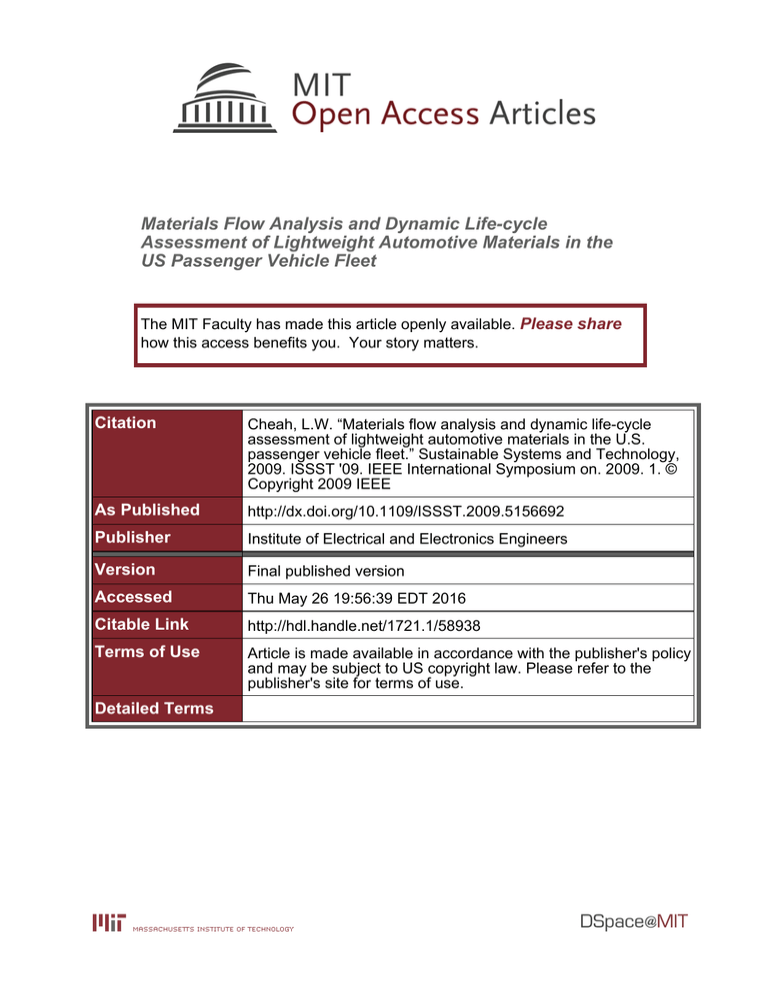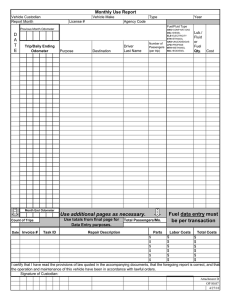Materials Flow Analysis and Dynamic Life-cycle US Passenger Vehicle Fleet
advertisement

Materials Flow Analysis and Dynamic Life-cycle Assessment of Lightweight Automotive Materials in the US Passenger Vehicle Fleet The MIT Faculty has made this article openly available. Please share how this access benefits you. Your story matters. Citation Cheah, L.W. “Materials flow analysis and dynamic life-cycle assessment of lightweight automotive materials in the U.S. passenger vehicle fleet.” Sustainable Systems and Technology, 2009. ISSST '09. IEEE International Symposium on. 2009. 1. © Copyright 2009 IEEE As Published http://dx.doi.org/10.1109/ISSST.2009.5156692 Publisher Institute of Electrical and Electronics Engineers Version Final published version Accessed Thu May 26 19:56:39 EDT 2016 Citable Link http://hdl.handle.net/1721.1/58938 Terms of Use Article is made available in accordance with the publisher's policy and may be subject to US copyright law. Please refer to the publisher's site for terms of use. Detailed Terms Materials Flow Analysis and Dynamic Life-cycle Assessment of Lightweight Automotive Materials in the U.S. Passenger Vehicle Fleet Lynette W. Cheah, Engineering Systems Division, Massachusetts Institute of Technology P ASSENGER vehicles in the U.S. are responsible for nearly 70% of the nation’s liquid fuel use, and 18% of greenhouse gas (GHG) emissions. These impact figures are increasing and motivate policy efforts to curb them, such as defining higher vehicle fuel economy standards. To achieve better fuel economy, automakers are seriously considering vehicle weight and size reduction. This is achieved by using lighter-weight materials like high-strength steel and aluminum, better vehicle design, and offering smaller vehicle models. To consider the effectiveness of these approaches, it is important to take into account the dynamic life-cycle energy and environmental impacts. For instance, primary aluminum requires almost four times more energy to produce than steel today. Expected efficiency improvements in material processing would modify this ratio over time. Examining the impact of lightweighting on the overall vehicle fleet systemlevel, as opposed to a single vehicle-level, also reveals insights on the timing and degree of the impact reduction achieved. RESEARCH OVERVIEW The research applies a dynamic approach to LCA, in combination with MFA and scenario analysis. It explores (i) the degree of lightweighting that is likely to be employed in order to meet the Corporate Average Fuel Economy (CAFE) target of 35 miles per gallon (MPG) by year 2020; and (ii) given scenarios of evolving vehicle weight, size and material composition, the corresponding fuel use and life-cycle GHG emission reductions that can be achieved on the vehicle fleet level. Spreadsheet-based models of the vehicle stock, automotive material use, and the corresponding life-cycle energy use over time, from 1980-2035, have been developed. Data from Argonne National Laboratory’s GREET life-cycle inventory database and other sources are used to derive the corresponding life-cycle energy and GHG emissions of all U.S. passenger vehicles over this period. ILLUSTRATIVE RESULTS Annual fuel use by the vehicle fleet is one of the outputs of the model. Two scenarios are shown in Fig. 1 – one “conservative”, and one more “optimistic”, which has new vehicles meeting the CAFE target and then doubling their fuel economy by 2035. The degree of lightweighting in future vehicles necessary to meet the proposed fuel economy target, in combination with the use of advanced powertrains, is found to be in the order of 15-25%. Fig. 2 shows the corresponding fuel savings achieved by the fleet. Under the “optimistic” scenario, the cumulative fuel savings through 2035 is 3,400 billion liters. Future work is committed to identifying factors in the material production and vehicle design stages that are most effective in or sensitive to reducing the overall energy and environmental impact of U.S. passenger vehicles. 1,800 New car curb weight (kg) 1,600 1,400 1,200 Baseline Conservative scenario Optimistic scenario 1,000 800 600 New vehicle fuel economy (MPG) 60 50 40 30 20 10 0 1980 CAFE target 1990 2000 2010 2020 2030 2040 Fig. 1. Curb weight and fuel economy of the average new vehicle. 1000 Vehicle fleet fuel use (billion liters) 800 2,580 600 830 bil liters 400 200 0 Baseline Conservative scenario Optimistic scenario Fig. 2. The corresponding impact on annual fleet fuel use in the two scenarios.



